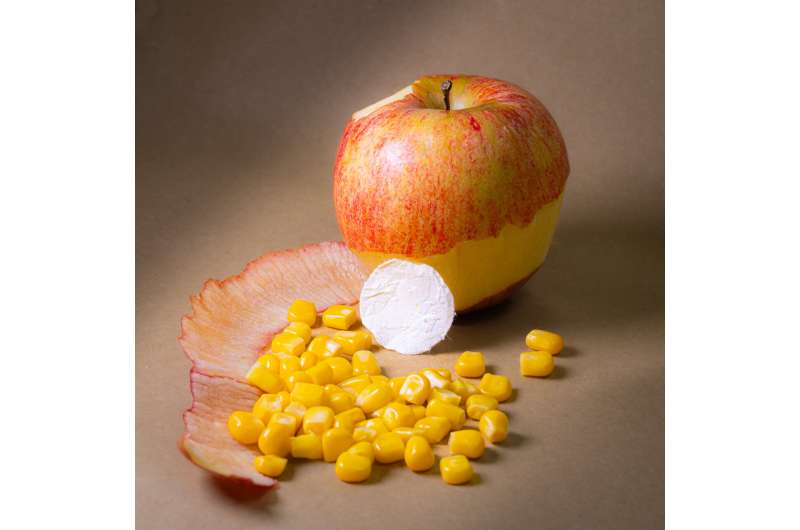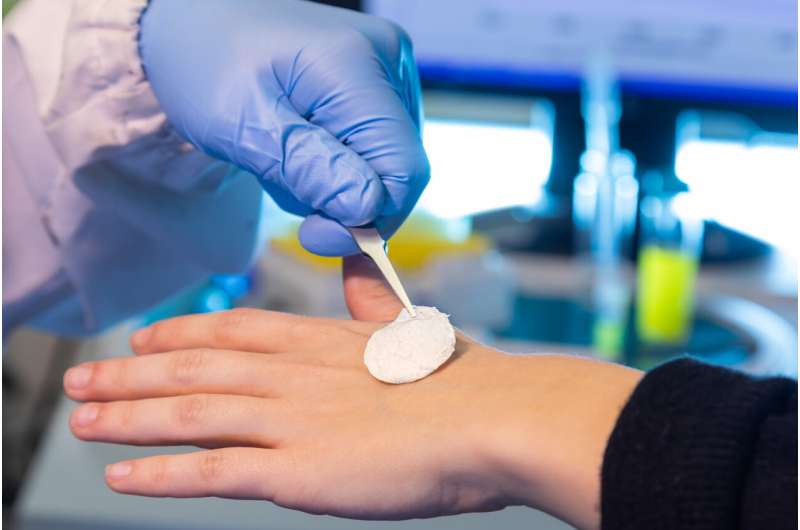This article has been reviewed according to Science X's editorial process and policies. Editors have highlighted the following attributes while ensuring the content's credibility:
fact-checked
trusted source
proofread
Scientists show how to treat burns with an environmentally friendly plant-based bandage

The Smart Materials research group, coordinated by Athanassia Athanassiou at the Istituto Italiano di Tecnologia (Italian Institute of Technology), has developed a biocompatible bandage made of plant-based materials that, loaded with vitamin C, can accelerate the healing process of burn wounds.
Published in the journal ACS Applied Bio Materials, these findings offer potential for the development of similar products to treat various types of skin injuries, including lacerations and ulcers. Additionally, the new bandage represents a promising, environmentally sustainable alternative to skin patches.
Following a burn, the affected area typically undergoes redness and swelling as a result of inflammation, the body's natural defense mechanism. Yet, excessive inflammation can counterproductively trigger the generation of oxygen free radicals, impeding the healing process.
Addressing this concern, researchers at IIT have devised a biocompatible bandage capable of blocking an excessive increase in the level of inflammation and reducing the number of free radicals, thus shortening the time needed for healing. Furthermore, the bandage naturally degrades within a few days, mitigating concerns about additional waste generation.
The bandage is made from a new biodegradable material developed by the team, consisting of zein, a protein obtained from maize; pectin, a sugar found in the peel of many fruits, like for example an apple; and soy lecithin, a substance sourced from the like-named plant.
Exploiting its porous texture, the bandage is impregnated with Vitamin C, renowned for its innate anti-inflammatory and antioxidant properties. Once applied to the burn, it gradually releases Vitamin C, thereby stabilizing inflammation levels and mitigating the production of free radicals.

The product's compatibility with human cells, a key feature determining its possible future use on human beings, has been demonstrated by in vitro laboratory tests on keratinocytes, the cells that constitute the skin.
These tests have also shown that the levels of three key molecules linked to inflammation (interleukins IL-1β, IL-6, and tumor growing factor TNF-α) decreased by 50% in the presence of the bandage, compared to when it was not in place.
Furthermore, the same comparison revealed a reduction—up to 70% less—in the number of oxygen free radicals. Lastly, an increase in the production of collagen, a crucial molecule in skin healing processes, along with an increase in fibroblasts, the cells involved in wound repair, was observed.
To validate these results, a series of preclinical tests were performed, demonstrating the product's ability to reduce inflammation. All this evidence highlights the efficacy of the bandage developed by IIT in accelerating healing from burns.
"For this bandage, we began with the idea of using solely materials of natural origin, but now we would like to go even further," said Fabrizio Fiorentini, researcher at the Smart Materials laboratory. "The objective will be to create a very similar product, but using substances derived from food waste in order to satisfy the circular economy concept."
"This is just one of the possible applications for this category of smart materials," said Athanassiou, Principal Investigator of IIT's Smart Materials Unit.
"We are working on other devices capable of speeding up healing, not only of burns, but also various other types of wounds such as lacerations or skin ulcers, pathologies that affect over half a million people in Italy and often limit personal independence."
More information: Fabrizio Fiorentini et al, Plant-Based, Hydrogel-like Microfibers as an Antioxidant Platform for Skin Burn Healing, ACS Applied Bio Materials (2023). DOI: 10.1021/acsabm.3c00214
Provided by Italian Institute of Technology




















